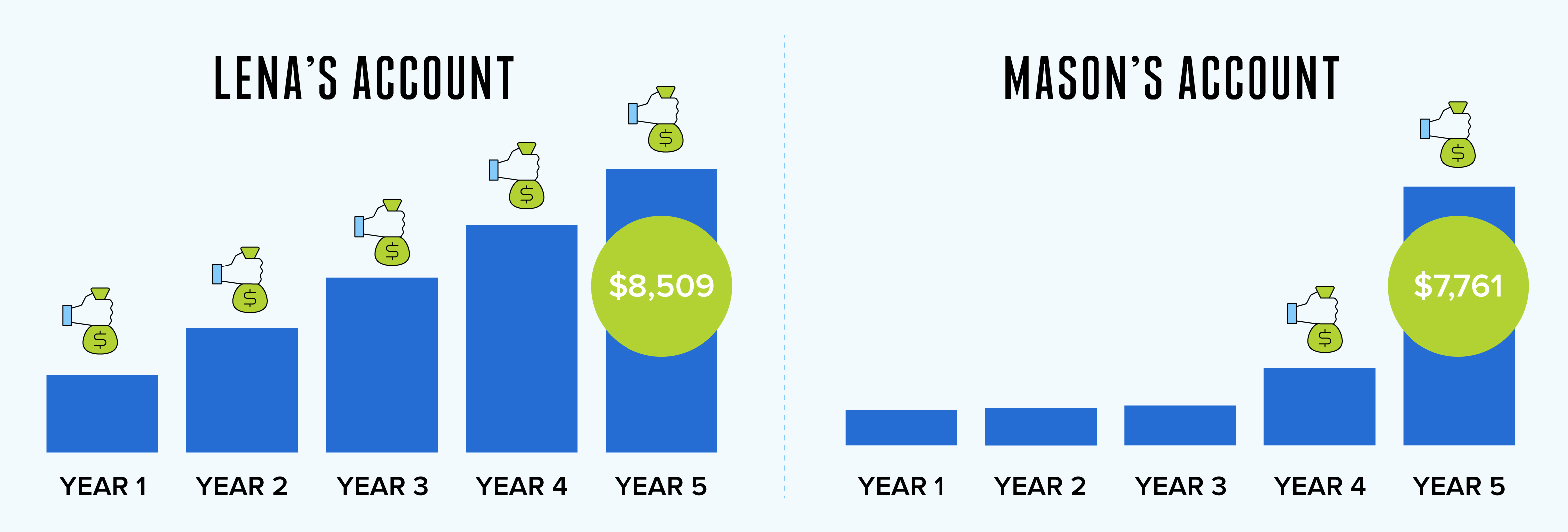One of the biggest obstacles to saving for college is getting started. But once you open a 529 plan, you can handle just about any obstacle—like rising tuition, unpredictable markets, or a tight budget—that gets in your way. The key is to focus on what you can control.
 Obstacle 1: Rising tuition
Obstacle 1: Rising tuition
In the last 10 years, the cost to attend college has increased at private and public four-year schools.
In 2024-25, the average published (sticker) tuition and fees for full-time undergraduate students are:
- Public four-year in-state: $11,610, $300 higher than in 2023-24.
- Public four-year out-of-state: $30,780, $940 higher than in 2023-24.
- Public two-year in-district: $4,050, $100 higher than in 2023-24.
- Private nonprofit four-year: $43,350, $1,610 higher than in 2023-24.1
1https://research.collegeboard.org/trends/college-pricing/highlights
Your goal
Families reported spending an average of $28,409 on college in academic year 2023-24, a 1% increase from $28,026 in 2022-23. Parents’ income and savings funded the largest portion of college costs (37%), followed by funding from scholarships and grants (27%). The remaining college costs were covered by student borrowing (12%), student income and savings (11%), parent borrowing (11%), and relatives and friends (2%).2
2https://www.salliemae.com/about/leading-research/how-america-pays-for-college/
Rather than trying to save enough to cover four years at a public college, save what you can. Even $500 can help your child pay for books, technology, or fees.
Your saving habits
You’ve probably heard it before: Save as much as you can for college. But it may be even more important to focus on how you save. When you regularly contribute to a 529 plan—weekly, monthly, quarterly, or annually—you reinforce the habit. And every dollar you invest has as much time as possible to generate its own investment returns thanks to compounding.
Here’s a hypothetical example showing the difference consistency plus timing can make:

This hypothetical example does not represent the return on any particular investment and the rate is not guaranteed.
Lena’s parents open a 529 with $1,000 and contribute $1,200 each year for 5 years. Mason’s parents also open a 529 with $1,000. They make no contributions for 3 years, but then invest $1,000 in year 4 and $5,000 in year 5.
Both sets of parents invested a total of $7,000 in an account earning 6% annually. All factors were the same except their saving habits. Lena’s parents split their additional investment of $6,000 into equal, regular contributions while Mason’s parents made sporadic contributions that had less opportunity to compound.
Lena’s account earned almost $1,509 over the 5-year period for an end balance of almost $8,509. Mason’s account earned just $761—$191 during the first 3 years, $131 the fourth year, and $439 the fifth year—for an end balance of $7,761.*
 Obstacle 2: Unpredictable market returns
Obstacle 2: Unpredictable market returns
Market volatility can be unsettling, but it’s a normal part of investing that’s completely out of your control. To prepare for market ups and downs, play offense, not defense. Here’s how:
Invest in a strategically diversified portfolio
With a NY 529 account, you can choose target enrollment portfolios that automatically shift your investments to more conservative portfolios as your timeline for making withdrawals gets closer. When you invest in target enrollment portfolios, your time horizon—not market movement—drives changes to your asset mix.
If you’d like more involvement, you can choose an individual portfolio that lets you design and manage your investment strategy. Set and rebalance your asset mix to fit your goals, risk tolerance, and time horizon to factor in market volatility up front.
Think long-term
Short-term swings can distract you from seeing the bigger picture. Stay focused on the long-term and stick with your financial plan for your best chance of reaching your goal.
 Obstacle 3: Saving on a tight budget
Obstacle 3: Saving on a tight budget
If you’re like most families saving for college, your household expenses compete with your savings goals. Here are a few tips to maximize college savings without blowing your budget:
- The NY 529 Plan offers an automatic investment plan so money is transferred directly from your bank account to your 529 plan on a set schedule. This makes it easy to save regularly, and it earmarks money for college savings before it can be spent on other priorities. You can start small and reevaluate the amount you invest every few months.
- Ask family and friends to consider contributing to your child’s Direct Plan account on special occasions. You can create a Ugift code that makes it easy for others to deposit money directly into your account. You can also use a portion of the money gifted to your child to make a 529 contribution.
- If you live in a state like New York that offers a tax deduction for 529 contributions, you may be able to offset some or all of your state income tax liability with 529 contributions, which is a win for you and your child. But don’t wait until tax time—you need to invest in your 529 account by the end of each calendar year to take advantage of the benefit.
Once you overcome the initial obstacle of opening a NY 529 plan, you’re primed to handle any hurdles that get in your way. Saving for college amid rising costs, unpredictable markets, and a tight budget are no match for an investor who takes advantage of the factors they can control.
Trends in College Pricing Highlights - College Board Research. (n.d.).
How America Pays for College 2024. (n.d.). Sallie Mae.
* These calculations do not reflect management, administrative, and other fees associated with 529 Plans. These results serve as hypothetical illustrations and do not reflect actual rate of growth. Investment returns are not guaranteed, and you could lose money by investing in a 529 plan.

